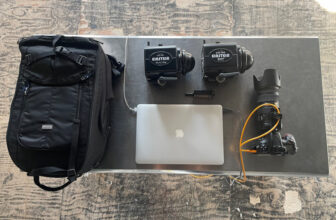
If you’re wondering what some of the AI features and tech powering your smartphone camera are, this article is for you.
Remember the days when phone cameras were mostly a backup plan?
The images were grainy and lifeless with muddy shadows and blown-out sky.
Today, we’ve come a long way from that.
Some of my recent phone shots had people asking what camera I use. That’s because the image quality is pretty good, and the photos, in a way, replicate what you’d expect from a professional camera and lens setup.
But what people don’t realize is that it’s artificial intelligence, not just the hardware, that’s doing the heavy lifting.
If you’re clicking pictures with a smartphone today, AI is doing more than just smoothing skin or brightening shadows. It’s reading the scene, deciding what’s important, and in some cases, ‘building’ a photo that technically can’t exist.
That’s a shift in photography as we know it, but also in the authorship. Let’s dive deeper into how AI works in our smartphone cameras and its implications.
AI Features in Smartphone Cameras
Credit – Samuel Angor
Before we discuss the AI tech built into smartphones, let’s first understand why your phone camera needs AI.
Smartphones have tiny sensors that are at best the size of your fingernail. If you go by the physics of imaging, that small a sensor can’t produce the details and resolution that you see in the results from pro cameras.
But the current generation smartphone cameras can create images that surpass the hardware limitations of these small sensors and lenses.
To overcome those limitations, manufacturers went the software route. And with further developments, AI became the backbone of the advanced imaging tech in phones.
Nowadays, manufacturers also add custom image processing cores to chips like Apple’s A17 Pro or Google’s Tensor G3, which are tuned specifically to handle real-time photography decisions.
From my own hands-on testing of a few of the latest phones, I can confidently say these chips are doing more than just metering light. They’re interpreting scenes, often with great accuracy.
AI bridges the gap between compact hardware and your creative expectations.
Additionally, the built-in editors in newer smartphones can recognize subjects like people and pets, detect different scenes, and even learn your editing style to make more tailored adjustments. They can replace skies, remove objects or people, and much more.
Thanks to AI, the software now understands photography fundamentals.
Let’s take a look at some of the features in smartphone cameras that are powered by AI.
Smart HDR


Credit- Venti Views
High Dynamic Range mode in smartphones lets you capture a wide range of tonal values by merging photos shot at different exposure values.
The normal HDR mode sometimes struggles to expose certain parts correctly, but with AI-powered Smart HDR, things have shifted completely.
For example, I took a quick photo of a street at sunset, and was surprised to find both the sky and the shop signboard exposed correctly. That’s AI at work.
This new HDR mode is intelligent and trained on image data that helps it make better exposure decisions. It captures multiple photos in milliseconds and blends them using AI to preserve details in bright highlights and deep shadows.
Unlike previous HDR modes, it doesn’t just average the shots, but rather balances the tonal values of different parts of the image, like skies, faces, and buildings.
Newer iterations even distinguish facial tones from background contrast and preserve natural skin tone. They take advantage of AI processing cores along with dedicated image signal processors to perform these tasks in real time.
Night Mode
Night Mode has been one of the most noticeable shifts in smartphone photography. I’ve tested it on multiple latest phone models, including the iPhone 16 Pro and Pixel 9.
Low-light photography can be a challenge for even pro cameras, but with these new phones, the results were surprisingly sharp and bright.
Again, AI is working behind the scenes. The phone takes multiple long exposures, aligns them if there’s some hand shake, and uses AI to remove noise without sacrificing details.
Earlier versions of Night Mode would often turn photos into a blurry mess, but now you can rely on your phone’s camera to produce usable images.
But here’s the thing: Night Mode is often creating a version of the scene that your eyes didn’t actually see. That’s something to keep in mind, especially if you’re sharing it as documentary photography.
Even shadows and highlights are adjusted differently across regions of the image. For photographers working in low light, this feature has made phone photography viable where it once wasn’t.
Scene Detection
Scene detection is one of those features that works so quietly you might not even notice it until you compare results.
When testing phones in different environments, I saw how the camera subtly shifted settings when pointed at food, faces, or landscapes.
Skin tones were warmed, blemishes lightened, food colors popped, and text was sharpened.


Credit- Willian Justen de Vasconcellos
Most flagship smartphones use AI that’s trained on millions of images to very accurately identify what you’re shooting and adjust everything from color temperature to focus behavior.
It works in most cases; however, occasionally, it misreads a scene and gives results that feel off or overly stylized. However, most phones allow you to disable it manually.
The more data the underlying AI is trained on, the more precise it becomes. Some phones like Google’s Pixel now recognize nuanced categories like “golden hour street scene” and optimize accordingly.
Portrait Mode
This is one of the most used features in phone cameras these days, and with good reason.
Portrait mode allows you to create out-of-focus backgrounds that are typical of wide aperture prime lenses like 35mm f/1.2 or 50mm f/1.4.
The tech is a mixture of AI and the hardware required to sense depth, such as LiDAR or depth lenses. Some manufacturers also use machine learning models for depth estimation.
Phone cameras can now separate subject from background and simulate bokeh with impressive precision.
With recent phones, edge detection has improved significantly. Complex hair, glasses, and even textured clothing are now handled well. That being said, phone cameras still struggle at times with busy backgrounds or semi-transparent objects.
What stands out to me is the post-shot flexibility in most of the flagship phones. I can now change the depth-of-field or adjust focus after the image is taken, which is something that even professional cameras can’t do.
Some models, like the latest iPhones, now allow adjustments like changing the direction of light on a face or subtly reshaping the blur pattern that simulates different lenses.
In a way, this isn’t photography anymore, it’s an AI-generated ‘interpretation’ of physics.
AI Super Zoom
Digital zoom on phone cameras used to be a nightmare for image quality and details. But with AI super zoom, things have changed drastically.
Some manufacturers, like Huawei, offer an AI zoom feature in their phones.
It works by adding details with the help of artificial intelligence. When zoomed beyond the optical range of the phone camera, the software uses machine learning to rebuild patterns like windows, signs, or textures based on what it has learned from similar photos.
However, while the results are sometimes sharp and convincing, at other times, you can tell it’s guessing.
For faraway subjects like signs or architecture, it can be useful. But I wouldn’t rely on it for anything critical.
One thing should be noted: like other AI features in phone cameras, the results you’re getting are imagined and not real. Though in some cases, they can be very close to reality.
Some high-end phones now include AI-powered vibration reduction and atmospheric compensation, helping reduce haze or heat distortion.
These additions, along with the AI zoom, make the photos look more realistic.
Blur Reduction
This is one of the features that’s easy to overlook but can be incredibly useful.
In my testing, I saw how phones now better handle fast movement. A kid running, a pet jumping, or even cars passing by: AI predicts the motion path, captures burst frames, and selects the sharpest one.
That means fewer blurry shots and more keepers, without needing to manually perfect the timing.
It’s a subtle but useful upgrade for anyone shooting action.
More advanced versions, like those found in Sony’s flagship phones, can also track not just objects and people but even the type of movements. They can recognize a person walking across the frame vs. one approaching it and adapt the focus and shutter accordingly.
AI in Photo Editing


Credit- Fabio Alves
What used to take half an hour in Photoshop can now be done on your smartphone in a few taps.
Many manufacturers ship their own versions of photo editors with AI capabilities. However, the one that stands out is Google Photos’ built-in editor.
It comes with tools like Magic Eraser that can remove unwanted objects from your photos. It can also replace sky in your photos or make selective edits.
The Unblur tool in Google Photos’ editor can sharpen certain types of motion blurs in your photos and make them sharp.
All these features take advantage of AI algorithms in the backend.
Samsung and Xiaomi’s built-in photo editing apps are also among the best.
The “Enhance” button on most apps works by applying multiple corrections intelligently, such as shadow recovery, noise reduction, and contrast tweaks, all without making the image look over-processed.
I found that these tools mostly work well. However, it’s easy to go too far, as with other editing software like Lightroom. Often, one or two tweaks are enough.
We’re also seeing AI-powered retouching tools that adjust lighting, facial expression, and background tones.
Behind-the-Scenes AI Tech in Smartphone Cameras


If you’ve read this far, you must be wondering how AI tech like machine learning, computational photography, and neural networks work.
Modern cameras rely heavily on what happens before and after the light hits the sensor. From the moment you frame your shot, AI systems are evaluating what you’re looking at, identifying context, and running predictive models.
Let’s break down all the AI tech terminologies and what they mean.
Computational Photography
You’ve likely heard the term “Computational Photography” multiple times, but do you know what it really means?
It’s the foundation of smartphone imaging today that allows smartphones to go beyond the limitations of optics, sensor size, and focal length, etc.
It’s the tech that allows merging multiple exposures, adjusting tones dynamically, and filling the gaps in a frame using algorithms.
Say you shoot a high-contrast sunset portrait. With computational photography, your phone would likely capture several exposures at once, for highlights, shadows, midtones, and maybe some optimized for the face. AI then stitches them together while balancing contrast, color, and skin tones.
What’s impressive is how seamlessly this process happens, and it’s hardly noticeable while shooting.
That was one use case, but there are many other ways computational photography is used in combination with other tech in phones.
Convolutional Neural Networks (CNNs)
CNNs are the deep learning networks that help phones make sense of visual data.
These are trained on massive datasets of photos that include everything from landscapes and selfies to animal and food shots. What this means is that when you aim your camera at something, the phone already has an idea of what it’s looking at.
The early layers of a CNN detect basic shapes and edges. The deeper layers identify more complex patterns like faces, buildings, animals, and more.
That’s how your phone knows to keep a human face sharp while softly blurring the background in Portrait Mode.
This also enables features like facial recognition, mood analysis, and the ability to separate the subject from the background with precision.
Real-time Machine Learning
Smartphone chips include dedicated neural processors, custom-built to handle AI tasks.
These chips are capable of processing millions of operations per second.
This is what allows your smartphone to make real-time adjustments like sharpening specific areas, reducing noise, and tweaking white balance selectively for skin tones and sky.
Many models also take advantage of federated learning, where your edits and preferences help train the global model anonymously.
This means your phone gets smarter the more you use it without compromising on privacy.
What About Ethics in Photography in the Era of AI?


Credit- Jonatan Pie
There’s no question that AI has made smartphone photography more powerful. But it has also blurred some lines.
Who took the photo? You or the algorithm? When your phone replaces the sky or reconstructs a blurry building, is it still a photograph?
There’s no clear answer.
But it helps to know what’s happening under the hood and to use these tools consciously, especially when the goal is authenticity.
We now face questions around image ownership and public trust. If AI fills in half the image, can we claim authorship? And should viewers be informed?
The answers are still not conclusive, as some people treat it as creative freedom, the kind we had with Photoshop, but some argue it’s hard to believe what’s real anymore.
Final Thoughts
Smartphone cameras have come a long way, and AI is no longer just a feature; it has become part of the photographic process.
Your phone now thinks about photos like photographers do. And while it’s not a replacement for creative vision, it definitely changes what’s possible.
I feel the best approach is to use AI when it helps, but be mindful of when it changes the story. Just because it’s smart doesn’t always mean it’s right.
Credit : Source Post






